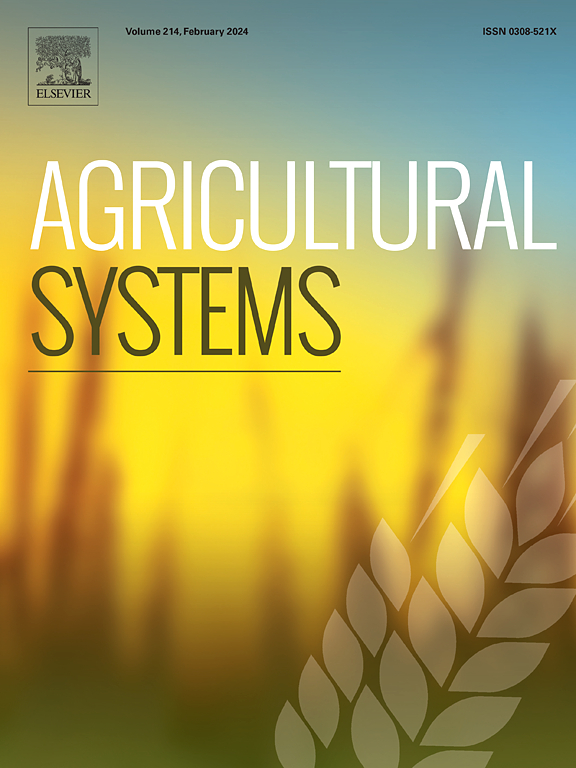战略性地使用基于指数的霜冻保险来降低财务风险,提高澳大利亚小麦生产者的收入稳定性
IF 6.1
1区 农林科学
Q1 AGRICULTURE, MULTIDISCIPLINARY
引用次数: 0
摘要
霜冻造成的损失破坏了春小麦种植的财务可持续性,这通常通过作物晚播来管理。虽然晚播可以降低霜冻风险,但由于作物发育后期高温和干旱胁迫的风险增加,它可能会影响产量。目的开发和测试一种新型的定向霜冻指数保险,称为加热度日温度最低呼叫选项,它允许农民更早种植,增加他们获得更高产量的机会,同时在霜冻事件的情况下为他们提供经济保护。方法采用作物模拟模型对保险的潜在价值进行研究。基于农业生产系统模拟器(APSIM)建模框架和指数保险结构对澳大利亚小麦种植区40多年来22个受霜冻影响的农场的整合,我们(i)确定了最佳播种日期和潜在的产量效益,(ii)估计了霜冻对该日期播种作物的产量影响。(iii)研究了基于指数的霜冻保险选择的效用,如果农民在最佳日期播种,假设他们每年播种并为作物投保,则可以在经济上保护他们免受霜冻风险。结果与结论在所有模拟的农场中,在最佳播种日期播种的农场都有收获。在经常发生霜冻的地方,使用目标霜冻指数有助于确保增加的回报,因此,效益。将霜冻指数保险与最佳播种日期有针对性地结合起来,特别是在霜冻易发地区,可能是减少财务影响和提高收入稳定性的重要策略。在经常发生霜冻的地区使用目标霜冻指数可以帮助确保增加收益,从而使农民和更广泛的社区受益。将霜冻指数保险与最佳播种日期有针对性地结合起来,特别是在易霜冻地区,可能是减少全球受霜冻影响地区的财务影响和提高收入稳定性的一项重要战略。我们不知道是否进行过类似的研究。本文章由计算机程序翻译,如有差异,请以英文原文为准。

Strategic use of index-based frost insurance to reduce financial risk and improve income stability for wheat producers in Australia
Context
Losses due to frost undermine the financial sustainability of growing spring wheat, which is often managed by the late sowing of crops. While late sowing may reduce frost risk, it can compromise yields due to increasing risks of heat and drought stress later in crop development.
Objective
To develop and test a novel targeted frost index insurance cover called the heating degree day temperature minimum call option, which allows farmers to plant earlier and increases their chances of attaining higher yields while also financially protecting them in case of a frost event.
Methods
The potential value of the insurance was investigated using crop simulation modelling. Based on the integration of the Agricultural Production Systems sIMulator (APSIM) modelling framework and index insurance structures for 22 frost-affected farms over 40 years in Australia's wheat growing regions, we (i) determined the optimal sowing date and potential yield benefits, (ii) estimated the yield impact of frost for crops sown on that date, and (iii) examined the utility of index-based frost insurance options that may financially protect farmers from frost risk if they sow on the optimal date, assuming they sow and insure their crops every year.
Results and conclusions
On all farms modelled, gains were made on those sowed on the optimal date. Where frost occurred regularly, the use of the targeted frost index helped secure increased returns and, therefore, benefits. The targeted integration of the frost index insurance with optimal sowing dates, especially for frost-prone regions, may be an important strategy for reducing financial impacts and enhancing income stability.
Significance
The use of the targeted frost index where frost occurred regularly could help secure increased returns and, therefore, benefits to farmers and the wider community. The targeted integration of the frost index insurance with optimal sowing dates, especially for frost-prone regions, may be an important strategy for reducing financial impacts and enhancing income stability in frost-affected food bowls globally. We are not aware of any similar study that has been conducted.
求助全文
通过发布文献求助,成功后即可免费获取论文全文。
去求助
来源期刊

Agricultural Systems
农林科学-农业综合
CiteScore
13.30
自引率
7.60%
发文量
174
审稿时长
30 days
期刊介绍:
Agricultural Systems is an international journal that deals with interactions - among the components of agricultural systems, among hierarchical levels of agricultural systems, between agricultural and other land use systems, and between agricultural systems and their natural, social and economic environments.
The scope includes the development and application of systems analysis methodologies in the following areas:
Systems approaches in the sustainable intensification of agriculture; pathways for sustainable intensification; crop-livestock integration; farm-level resource allocation; quantification of benefits and trade-offs at farm to landscape levels; integrative, participatory and dynamic modelling approaches for qualitative and quantitative assessments of agricultural systems and decision making;
The interactions between agricultural and non-agricultural landscapes; the multiple services of agricultural systems; food security and the environment;
Global change and adaptation science; transformational adaptations as driven by changes in climate, policy, values and attitudes influencing the design of farming systems;
Development and application of farming systems design tools and methods for impact, scenario and case study analysis; managing the complexities of dynamic agricultural systems; innovation systems and multi stakeholder arrangements that support or promote change and (or) inform policy decisions.
 求助内容:
求助内容: 应助结果提醒方式:
应助结果提醒方式:


